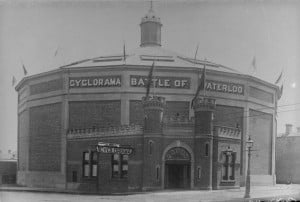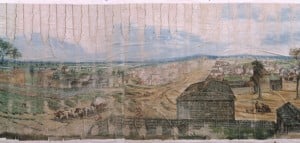The cyclorama emerged in the 1700s and became a popular form of entertainment at the turn of the 20th century before cinema rendered the genre obsolete. Essentially the same as the panorama patented by Robert Barker in 1787, the cyclorama is a huge 360-degree oil on canvas painting (15 x 122 metres). Mounted on the inside walls of a large purpose built circular building, they presented historic events such as famous battles.
The picture was viewed from a central platform, giving the spectator the feeling of being in the middle of the depicted scene. There was often accompanying music, sound or narration and real objects, such as trees and bushes, heightening the illusion created by the picture.
Cyclorama, H91.325/1953
Cycloramas were introduced to Australia by American promoters Howard H. Gross and Isaac Newton Reed and were popular between 1889-1906. The country’s first cyclorama opened in George Street, Sydney in March 1889 presenting ‘The Battle of Gettysburg’. Two months later a similar cyclorama opened in Melbourne presenting ‘The Battle of Waterloo’. The cyclorama building in Melbourne was a large hexagonal building designed by George Johnson situated in Victoria Parade, Fitzroy (now St Vincent’s hospital) and then referred to as Eastern Hill. It cost £6,500 pounds to build, the picture was 1858 square metres and valued at £20,000, with the whole exhibition costing £30,000.
Later that year a group of local investors bought the cyclorama from Gross and Reed to form the Melbourne Cyclorama Company. The directors of the Company included Henry Byron Moore, Henry Gyles Turner, Lloyd Tayler and theatre entrepreneur James Cassius Williamson. Gross and Reed continued to supply the newly formed company with other pictures from their collection, including ‘The Battle of Gettysburg’. Each picture cost £2,500 pounds. ‘The Battle of Waterloo’ was exhibited in Melbourne for four years and an advertisement claimed the picture had been seen by over 700,000 people.
[Eureka Stockade], H141890
A cyclorama of more local historical relevance to the Victorian public, ‘The Eureka Stockade‘ opened in 1891. The 1854 rebellion of gold-miners against exorbitant licence fees was still quite recent and the story surrounding the events was gaining legendary status. That same year, a second cyclorama building was built on Bourke St and Little Collins St (now Georges Apartments). It opened with ‘The Siege of Paris’, which ran from 1891-1896. In 1893 the cyclorama building at Eastern Hill presented the Easter attraction ‘Jerusalem at the time of the crucifixion’ and in 1895 ‘The Battle of Gettysburg’ was installed. The pictures rotated between Melbourne, Sydney and Adelaide.
The Melbourne Cyclorama, 1889-1928 : photos of the Jerusalem Cyclorama, H2012.46- H2012.46/7
In 1892 John Hennings was commissioned by the Victorian colonial government to paint the ‘Cyclorama of Melbourne’, inspired by Samuel Jackson’s 1841 Panoramic sketch of Port Phillip. The panorama shows the partly built Scots’ Church on the corner of Collins and Russell Streets. The cyclorama was displayed at the Exhibition Building in 1892. It was significantly smaller in scale than commercial cycloramas measuring 36.6 x 4 metres. It remained on show for nearly 30 years until 1918 when the cyclorama was rolled up, stored and forgotten until March 1953, when it was damaged in a fire that destroyed a section of the Exhibition building. Three years later, the exhibition trustees donated the painting to the State Library of Victoria.
The Cyclorama of early Melbourne, H17709c
Bibliography
1. Colligan, M 2002, Canvas documentaries: panoramic entertainments in nineteenth-century Australia and New Zealand, Melbourne University Press, Carlton South, Vic.
Written by Sarah Ryan
Librarian, Australian History and Literature Team






Hello Sarah – You may not be contactable at this address but
I was in having a cup of coffee at Quist’s and saw the poster for the Cyclorama. Henry Byron Moore ( one of the Directors you list above) is my Great-grandfather. I have been going through his papers in the State Library and found some information on this amazing form of entertaining and imparting important information.
Hi Jane
Thank you for taking the time to comment on the blog. I certainly enjoyed reading up on the heyday of the cyclorama. Entertainment has changed dramatically in today’s digital age. Maybe there will be a cyclorama renaissance in a bid to re-engage with the analogue world. Your great grandfather was a real mover and shaker. I do love the bushranger/hipster beard he sports in the portrait accompanying his entry on the Australian Dictionary of Biography.
I am writing the first spreadsheet from the American point of view about 19th century rotunda panoramas. These were the biggest paintings in the world, 50 x 400=20,000 square feet, housed in their own rotundas which were 16-sided polygons. Chicago in 1893 had 6 panorama companies and 6 panorama rotundas. Reed & Gross from 1885-88 produced units of BATTLE OF GETTYSBURG and JERUSALEM ON THE DAY OF THE CRUCIFIXION at their studio in Englewood, then a suburb of Chicago. In autumn 1888 they removed their studio, panorama artists, and cycloramas to Australia, to set up 2 rotundas in Melbourne,1 in Adelaide,1 in Sydney.INFO TO SHARE
Hi Gene
Thank you for sharing the information you’ve come across in your research about 19th century rotunda panoramas. The panoramas certainly were immense. The Imax of the day. What a huge undertaking for Reed & Gross to completely uproot and move their operation Down Under. They were very popular until cinema took over as the preferred mode of entertainment.
A friend of ours lives in the George’s Apartments opposite the old George’s Department Store on Collins. It was formerly a cyclorama and showed a depiction of the Siege of Paris 1870-71. She also lives on Norfolk Island where they have built a modern day cyclorama showing the history of the island. Her building also contained a zoo along with the giant panorama. Is the book mentioned in the bibliography available.” Canvas Documentaries”, by M. Colligan available anywhere. What can I find out about this panorama at the State Library.
Hi Marlene
We hold the book ‘Canvas documentaries’ at the State Library. It’s also available at other libraries in Victoria and around the country. See holdings below.
https://trove.nla.gov.au/version/45849367
It’s also available to purchase from several booksellers listed below.
AbeBooks
https://www.abebooks.com/servlet/SearchResults?sts=t&an=&tn=canvas+documentaries&kn=&isbn=&sortby=93
HolisticPage
http://www.holisticpage.com.au/allproductresults.php?searchtype=&searchfield=0522850197
Books & Collectibles
http://booksandcollectibles.com.au/bnc_search/bnc_search/book_search.php?isbn=0522850197
We have digitised a pamphlet about the Siege of Paris cyclorama.
The Cyclorama of the Siege of Paris : History of the Franco-Prussian War / compiled by B.A. Reeve
http://search.slv.vic.gov.au/MAIN:Everything:SLV_VOYAGER1558252
You can also read about the cyclorama in digitised newspapers available through Trove, a website produced by the National Library of Australia.
https://trove.nla.gov.au/newspaper/result?q=siege+of+paris+cyclorama
I have a question: are there any panoramas currently showing anywhere in the world?
I am delighted to learn that panoramas were a popular form of entertainment in Australia. But the one I know best is in Hungary, in the National Heritage Park in Ópusztaszer. It depicts the “Arrival of the Hungarians” (895) and it was completed by 1894 for the millennium celebrations. It was painted by one Árpád Feszty and a team of other well known artists. After the millennium it was taken to London in 1899 for the Greater Britain Exhibition and returned to Budapest in 1909 for another showing and subsequently rolled up and put in storage. Unfortunately during WWII the building was badly damaged and the painting suffered badly, too. However in 1991 a Polish company Ars Antiqua won the international competition for the restoration of the panorama, which they completed for the 1100 years celebration of the subject of the painting.
The panorama in its purpose-built building is 15m high, 120m around with a 38.2 diameter. The landscaping between the central viewing platform and the painting is seamless, giving the visitor the impression of being inside the events depicted.
It is, for sure, a place of pilgrimage for Hungarians everywhere. I am lucky to have seen it twice, in 1996 and 2014.
An uplifting experience.
Hi Ildi
Glad you enjoyed reading about Cycloramas in Melbourne. Great to learn about the panorama in Hungary. We’ll see what we can find out about the current state of panoramas around the world and let you know.
Cheers
Sarah
Ildi, there is a panorama of the Battle of Waterloo still in existence at the memorial site in Belgium. http://www.waterloo1815.be/index.php?page=the-panorama
Hi Ildi
Is it not wonderful that these old panoramic views are coming to light in the form of new media. I have seen some amazing panoramic exhibitions held in the USA, which has encouraged me (in collaboration with the SLV and Mimi Colligan) to locate our own Melbourne Panoramas and bring them to life online for all to view.
These images come from a book held by the State Library and have been enhanced and joined to show a panorama of Melbourne from St Patricks Tower in 1889.
https://www.hiddenmelbourne.com.au/time-travel/1889johnsteelfromstpatricks/
Hi Sarah,
Thanks for your interesting blog.
Do you have any information about the Ballarat Cyclorama?
I have been told that my great grandfather’s brother-in-law, Francis Ackroyd, built one
in Ballarat but his timing was too late for it to be successful as it was just before silent movies came here.
Thanks,
Rosalie
Hi Rosalie
I’ve passed on your enquiry and we’ll respond via email.
Regards
Sarah
Hi Sarah
I was always told, my great grandfather was a lecturer at the Melbourne Cyclorama.
Hi Sean
Thanks for sharing your family connection to the Melbourne Cyclorama. There were a number of articles published in newspapers about the lectures at the Melbourne Cyclorama. You might be interested to look at the digitised articles available through the Trove website if you haven’t seen them already.
https://trove.nla.gov.au/newspaper/result?q=lecture+melbourne+cyclorama
Regards
Sarah
Sarah Ryan
I have been searching for missing frames of the view from the Eastern Hill Fire tower.
This 190–2016 Virtual tour which I created shows the Cyclorama building in 1905, but for 1904 and 1922 (Reg Lambert) half of the view is missing.
In the 2016 view which we captured, the Cyclorama is long gone.
https://www.hiddenmelbourne.com.au/1904-2016-eastern-hill-fire-tower/
Hi Barney
I love the virtual tour you’ve created and the way you’ve georeferenced the panoramas onto a Google map. I’ve tracked down a souvenir of the Eastern Hill Fire Station c1932 with a panoramic view of Melbourne taken from the Fire Brigade Tower. I think you’d be very interested to see it. The site of the old cyclorama is a construction zone for additions being made to St Vincent’s Hospital referenced in this article that appeared in the Argus from 1927.
Kind regards
Sarah